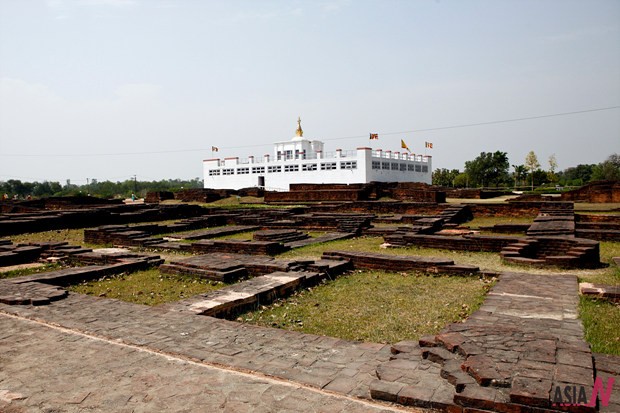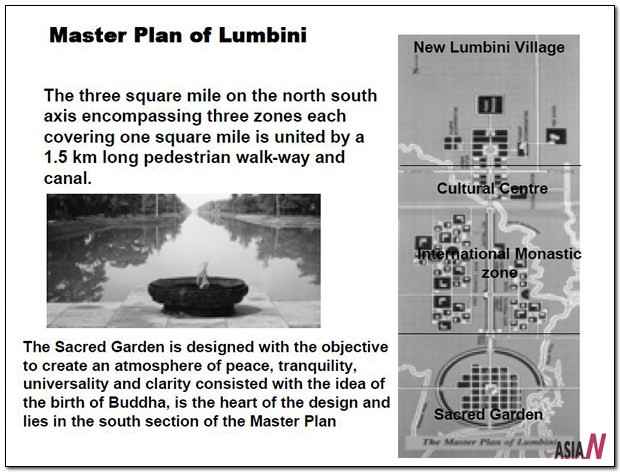What Makes Nepal Identify Lumbini’s Nationality
2012 as ‘Visit Lumbini Year’
The Nepali people have launched an aggressive campaign to promote the fact that Buddha was born in Nepal, not India. Nepal’s Ambassador to Korea Kamal Prasad Koirala wrote a letter on 19 December 2011 to President Lee Myung-bak requesting him to change the wrong information in South Korean textbooks regarding the birthplace of Lord Buddha.
According to a survey conducted by NRNA (Non Resident Nepalese Association) Korea in 2007, many people outside Nepal generally assume that Buddha was born in India, which is an incorrect piece of information. Mr Koirala said, “I have met many Koreans after I came to Korea in 2008 but things are pretty much the same.”
Why was it wrongly known?
Mr Koirala continued to explain, “The main reason for confusion is that colonization of India by Britain started in 17th century and the colonial rule ended in 1947. With colonization of India, British historians began to write its history in English. In these English histories, it was written that Buddha was born in India.”
Over 300 years from 17th until 19th century, the exact location of Lumbini was remained unknown. During these centuries, the place was covered by a thick forest and it is at a distance of 32 kilometres north of the border of India.
There are four most sacred places in regard to the life of Buddha and these are Lumbi – the birthplace, Bodhagaya – place of enlightenment, Sarnath – first sermon, and Kusinagar, death. The British historians were successful in finding out the three places except Lumbini. While they found all the three prominent places in India, probably, they might have reached in a false conclusion that the birthplace is also in India.
Upendra Yadav, the Minister of Foreign Affairs of Nepal said, “India is a large country with dense population and compared to India, Nepal is a relatively small country. Therefore, a lot of people just assume that Lumbini is also in India.” Anuradha Koirala, CNN hero of the year 2010 and also the founder of Maiti Nepal said, “It is true that India and Nepal are politically, socially, economically and culturally connected. However, India and Nepal are different countries with different identities.”
Famous Mauryan Emperor Ashoka with his spiritual guru Upagupta went on pilgrimage to Lumbini in 2on pilgrimage to Lumbini in 249 BC. He erected a stone pillar bearing an inscription stating clearly “Hido Budhe Jate Shakyamuni(Here Buddah was born)”. The inscription engraved by Emperor Ashoka is still intact and testifies the authenticity of the birthplace.
Basant Bidari, Chief archaeologist of the Lumbini Development Trust also emphasized the importance of the Ashoka stone pillar. He handed his powerpoint document about Lumbini to UNESCO.
The document Basant Bidari handed to UNESCO in regard to Lumbini
<Souce: UNESCO webpage>
Famous Chinese scholars Tseng Tsai(4th century), Fa-Hsien(5th century) and Hiuen-Tsang(7th century) visited Lumbini. In 1312, King Ripu Malla of Karnali, a princely king of West Nepal visited Lumbini and left the mark of his visit engraved on the top of the Ashokan pillar.
The association of Lumbini with Buddha went slowly to oblivion and the name Lumbini gradually changed to Rummindei and then to Rupandehi – the present name of the district.
Lumbini rediscovered
In 1887, the then Commander-in-Chief Khadga Shamsher was dismissed from his post and sent to exile in a place named Palpa in western Nepal. He heard that in the dense forest of the plain there is a manmade pillar. Khadga Shamsher ordered to clean trees around that pillar and dug the earth. There they went on finding the ruins and objects of a very ancient site. This news reached to Dr Alois Fuhrer, an imminent archaeological surveyor in British India and he went to that spot. He knew very well the Brahmi script and Pali language. He easily deciphered the inscription engraved on that ancient pillar. P. C. Mukharjee, another famous Indian archaeologist conducted an excavation in 1899 and indentified the nativity as well as some of the structural remains in and around the birthplace.
However, prior to this development, the history books by British historians were being translated in many languages around many parts of the world with the misinformation based on British archive. In early and mid 20th century, there were two world wars and the attention of the people was diverted to other things. Even after world wars, there were freedom struggles and civil wars prevalent in many parts of the world.
Then in 1967, the United Nations Secretary General U Thant’s pilgrimage to Lumbini became a milestone in the recent history of the development of Lumbini. In 1970 he helped formation of an international committee for the development of Lumbini consisting 15 member nations to support with the United Nation’s involvement. Korea, Japan, China, Vietnam, India, Burma, Cambodia, Germany, France and other countries have constructed sites in Lumbini representing their nation within the Master Plan of the Lumbini Development.
Ban Ki-moon, the present Secretary General of the United Nations said, “I am awestruck by the beauty and profound significance of this sacred site, the birthplace of Lord Buddha.” As of 1997, Lumbini is an UNESCO World Heritage Site specifically nominated for the International World Heritage Programme.
Last year, the British Museum on 7 November corrected its previous writing and archive. Since the Museum is visited by 60 million people every year, this correction is very important to Nepal. The Nepali government announced the official Visit Lumbini Year 2012 in an effort to attract a lot of tourists.
Saroj Mahato, a M. A. student at Korea National University of Arts recently made a documentary film supported by the Nepali government. The title is ‘Buddha born in Nepal’ and uploaded in YouTube. ‘Campaign for Lumbini’ is now seen everywhere both on and offline.
Lee Miyoung-hiyoun EnjoyMiracle@theasian.asia





I am happy that finally people have started to trust on reality. The world must know the the Buddha and his birthplace and the people should not trust on the propaganda that are beyond the reality. Come to Nepal and touch the reality!Thanks people and thanks to world!
म र व च रम य ल ट पन ह न, र employees ल र इ पन थ ह छ र सब ल र इ थ ह छ क य म उव द क ल गर क ह भन र, ह ल मल र इ म उव द क स र य वर लल (क ष त ज)भन न व यक त व त धम क द न द गर द द ल म र स र ट क ह लत वन इद न धम क द ए म ल स झद उनल न र धक क स ध भन क म ल न गर क ह र यसक स क ष म र समक षक क ह व यक त ल सम तल स न र य क र म ल म व इम स रक ष त reocrd गर क छ , य त यह व यक त ह न ज म द म वसम एम व स र ख र ध र व य क त ल र इ हट हट गर , यस त व यक त ल र इ सझ एक भग द र नगर सम म द शम स न त चयन अ उन द न, मल इ क ल ग छ भन sorry for employe भन द पन sorry for worner भन न मन ल ग य क नक म पन worner ह र employees ल त अन त पन क म प उन छ तर woner क त म हनत पन गय र द व ल पन न स क य न , मल र इक ल ग छ भन यस त क ह व यक त हर अझ पन य द द ज र न छ भन न ठ न दछन र अध स त य द द ज र न छ य सर व व भ तन छ